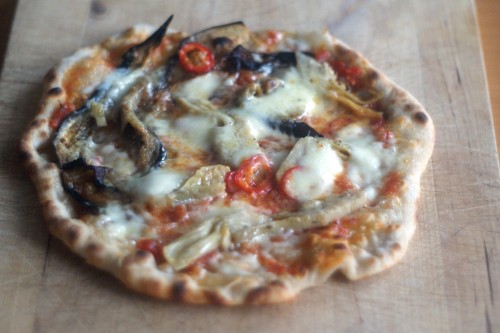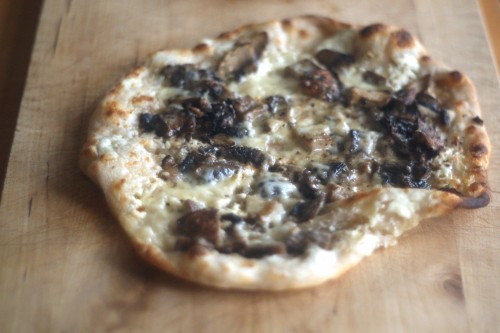
I’ve been making my own pizzas for a long time. I remember when I was still at school, trying to recreate the awesome pizzas at Croma with shop-bought pizza bases. I mean really, why did I bother? Those bases are so gross, anything would have been better. Even an old school baguette pizza.
I moved slightly up in the world when I discovered that flatbreads make a pretty acceptable pizza base and I still make them now when I can’t be bothered going all out.
But when we started making bread, we started experimenting with homemade pizzas as well. We usually make sourdough pizzas (and if you want to try, make the recipe here), but I find that any old bread dough will work.
The key to really good homemade pizzas is to go sparingly with the toppings (which I’ll cover later) and to cook the pizzas at as high a temperature as possible. This is where pizza stones come in and they need to be preheated in the oven until the oven is as hot as it will go. This helps to give that characteristic chewy crust. (Remember to dust the stone with a little semolina to stop the pizza sticking.)
Unfortunately, our trusty pizza stone broke recently so this time we experimented with frying the pizza for a few minutes first (to cook the base) and then finishing it under the grill. I have to say they worked out brilliantly – no soggy bases and the grill gives the pizzas that lovely burnished look.
As for toppings, I like olives, grilled pieces of aubergines or courgette, pine nuts, sliced chillis, really good salami or bacon. Once it comes out from the grill, I also like to top it with some rocket leaves dressed with lemon juice and olive oil. My other favourite is a white pizza, I spread the pizza base with crème fraîche and top with softened leeks or fried mushrooms and thyme. Oh, and for a totally legitimate breakfast – top the finished pizza with a fried egg.

For the pizza geeks among you, Dan Lepard wrote an excellent guide to making pizza and there’s also the Guardian’s How to make the perfect pizza.
To make frying pan pizza
- Make your pizza dough and factor in time for it to prove.
- Preheat the grill to high and slide in the heaviest baking tray you have.
- While the grill’s preheating, make a quick tomato sauce by frying finely chopped garlic in olive oil, adding a can of chopped tomatoes and simmering it for 10-15 minutes, or until thickened. Season with salt and freshly ground black pepper.
- Prepare the rest of your toppings so you’re good to go once the base is in the frying pan.
- To cook them in a frying pan, you’ll need to make smaller pizzas, so divide the dough into golfball-sized pieces and roll out as thinly as possible.
- Preheat a frying pan until medium-hot and add a little oil. Carefully place the pizza base into the frying pan and spread with a thin layer of tomato sauce. Scatter over your toppings and small pieces of mozzarella and grate over a little cheddar or parmesan. Finish with a drizzle of olive oil, especially around the edge.
- Carefully check that the bottom of the pizza is cooked and golden-brown in places (I use a fish slice), then slide the pizza onto the preheated baking tray and cook under the grill for a couple of minutes or until the cheese in melted and golden-brown.
Tags: pizza
YOU MIGHT ALSO LIKE...

that’s fab! I can’t believe you can make a really good homemade pizza on a frying pan. I’ve been looking at the guardian’s perfect pizza recipe too, and while useful and all good, it makes me just want to give up before even starting. thanks for the tips!
Dear Rachel, I made your white chocolate and hazelnut cake and used the exact measurements and baking tins too. The smell alone send me to heaven and I used lemon zest instead of vanilla…WOW. However I do have a question, how high are the cakes supposed to rise to? Mine rose to one inch each, is that normal? I am new at baking and would really appreciate your input.
Thanks, Grazia.
My purchased baking stone broke after about 6 months of use. I replaced it with a piece of kiln shelf (high fire ceramic) about 0.5″ thick, cut to fit the oven shelf allowing 1″ space on every side. Purchased from a hobby ceramics supplier. That was about 20 years ago and the slab of kiln shelf is just fine, although it’s now acquired a beautiful patina aka it was matte cream when new and is now mostly shiny and almost jet black. I leave it in the oven permanently, as it increases thermal mass for most cooking, gives more even heat distribution under cakes and so forth.
Someone on the sourdough usenet group bough a concrete paving slab for the same purpose, but complained it then took *ages* for his oven to heat!
Hi Rachel.
I came across your blog via a few links. When I got to yours it was a “wow” moment, not because your food and cooking looks amazing but because you are in Brixton. I was born in Clapham maaaaany years ago (just after the war) and emigrated, with my family, to Australia in 1959 so it brought back many memories. I did return in 2003 and saw such a change but found some things still very familiar. I will definitely check your blog for food inspiration. Thanks, Gill
Hi Gill,
Thanks for your lovely message! Brixton has changed so much even the past year or so that I think you would be surprised if you visited again. It’s mostly for the better I think, same old character, but with some amazing restaurants.